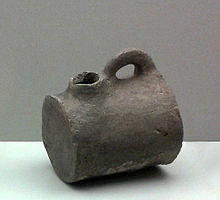| This article needs additional citations for verification. Please help improve this article by adding citations to reliable sources. Unsourced material may be challenged and removed. Find sources: "Botijo" – news · newspapers · books · scholar · JSTOR (July 2022) (Learn how and when to remove this message) |

A botijo, also called búcaro in Spanish, càntir in Catalan, canabarro in Galician, txongil in Basque, and boteja in Hispanic America, is a traditional porous clay container designed to contain water. The botijo, or water jar, is a typical element of culture in many parts of Spain and may vary in shape and color. Although the botijo can, exceptionally, also be found in glass, metal or even plastic, it is usually and traditionally made of clay, due to the properties of this material, such that, once the botijo is filled, it cools the water that it contains, acting as an evaporative cooler.
The botijo has a wide belly and one or more mouths where it is filled and one or more outputs, called pitón or pitorro (in Spanish), to drink from.

The oldest botijo found on the Iberian Peninsula belongs to the Argaric culture and was discovered in the necropolis of Puntarrón Chico (Beniaján), near the capital of the Region of Murcia, where it is preserved in the Archaeological Museum of Murcia. It is an important piece in the historiography of ceramics, being a 'closed work' with a single hole of 2 cm (0.79 in) and the handle placed on the top; the dimensions of the pitcher are 11 cm × 9.5 cm (4.3 in × 3.7 in).
The búcaro de Indias is a special type, made of fragrant clay from Mexico, that was prized in Europe.
Operation
See also: Evaporative coolerThe operating principle of the botijo, or any earthenware water jar, is as follows: the stored water is filtered through the pores of the clay and in contact with the outside dry environment (characteristic of Mediterranean climate), it evaporates, producing a cooling (2.219 kilojoules per gram of evaporated water). The key for cooling it, is by the evaporation of bleed water, as the water evaporates, it extracts thermal energy from the water stored inside the jug.
...because of the porous nature of the clay jar, which is unglazed, the water within will slowly seep out through the pores, and the warm air outside causes evaporation. This circulation and evaporation keeps the walls of the jar cool, and the water inside lowers in temperature, and becomes excellent for drinking.
Gallery
-
Botijo collection. Museo de Cerámica Nacional.
-
 El botijo (c. 1904) by Joaquín Sorolla
El botijo (c. 1904) by Joaquín Sorolla
-
 Thirst (1886) by William-Adolphe Bouguereau
Thirst (1886) by William-Adolphe Bouguereau
See also
- Olla
- Porró - another distinctively Spanish vessel, mainly traditional in Catalonia, Aragon, the Valencian Land and the Balearic Islands.
Notes
- "càntir". Gran Enciclopèdia Catalana (in Catalan). Barcelona. Retrieved 2023-07-17.
- "Museu del càntir | ARGENTONA". www.museucantir.org (in Catalan, Spanish, and English). Retrieved 2023-07-17.
- "Un càntir per a cada funció: les tipologies". Visitmuseum · Catalonia museums (in Catalan, Occitan, Spanish, English, and French). Agència Catalana del Patrimoni, Generalitat de Catalunya. Retrieved 2023-07-17.
- "canabarro". Dicionario da Real Academia Galega (in Galician). Real Academia Galega. Retrieved 2023-07-17.
- Amigo, Ignacio (August 22, 2019). "The Art, Science, and Allure of Spain's Water-Cooling Jugs". Atlas Obscura.
- Victoria and Albert Museum, Online Museum (November 10, 2011). "Let Them Eat Clay!". www.vam.ac.uk.
- "How to Keep Beverages Cool Outside the Refrigerator". www.notechmagazine.com. Retrieved 2022-09-01.
- "BOTIJO". Etimologías de Chile - Diccionario que explica el origen de las palabras (in Spanish). Retrieved 2023-05-31.
- Sempere Ferrándiz, Emili (2006). Historia y arte en la cerámica de España y Portugal. De los orígenes a la Edad Media. Les Puntxes. p. 88.
- "Covered jar | Mexican".
- The Clay-Worker. 85–86: 37. 1926. ISSN 0095-8425. OCLC 1397578.
{{cite journal}}: Missing or empty|title=(help)
External links
This Spain-related article is a stub. You can help Misplaced Pages by expanding it. |
This article about kitchenware or a tool used in preparation or serving of food is a stub. You can help Misplaced Pages by expanding it. |